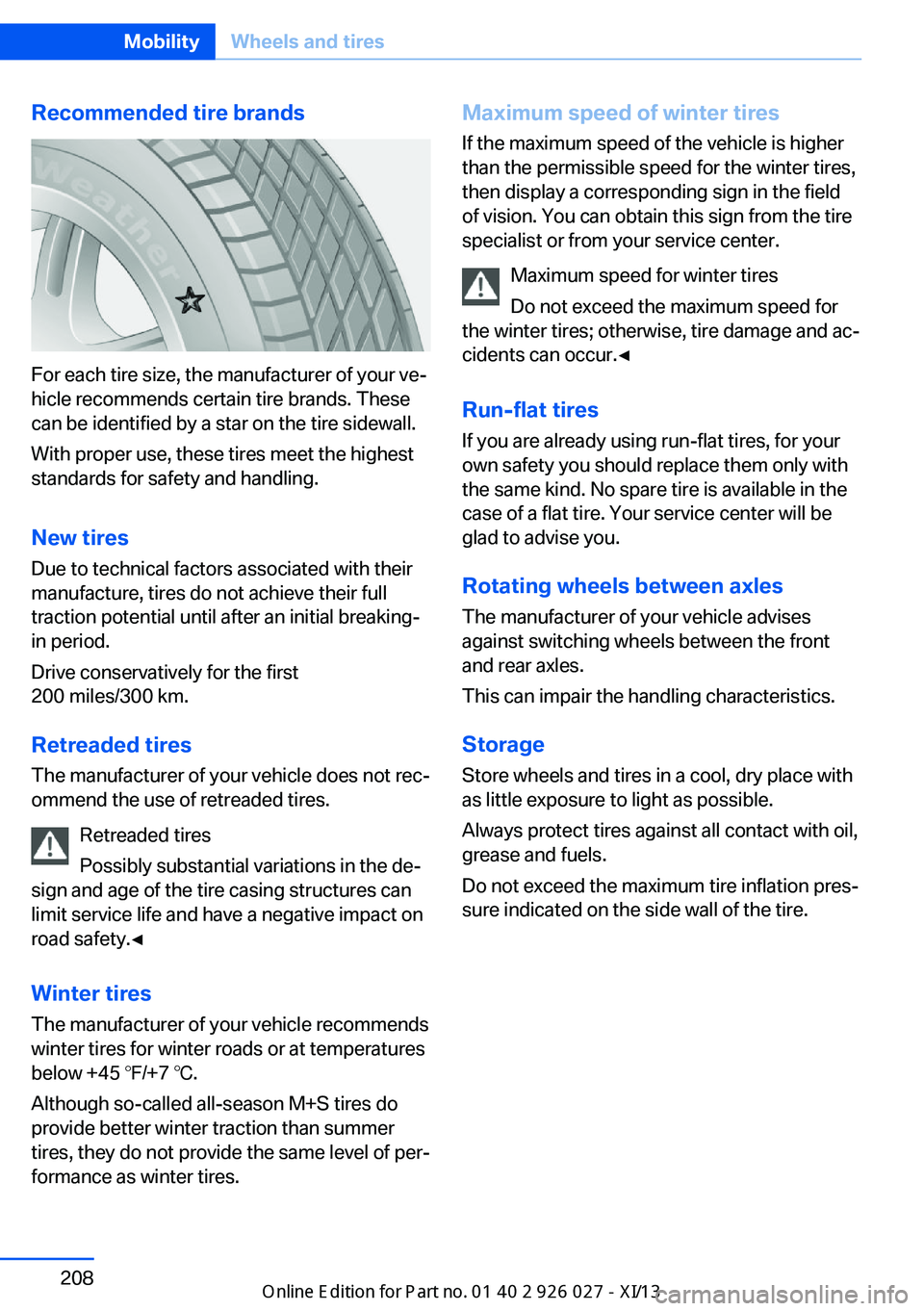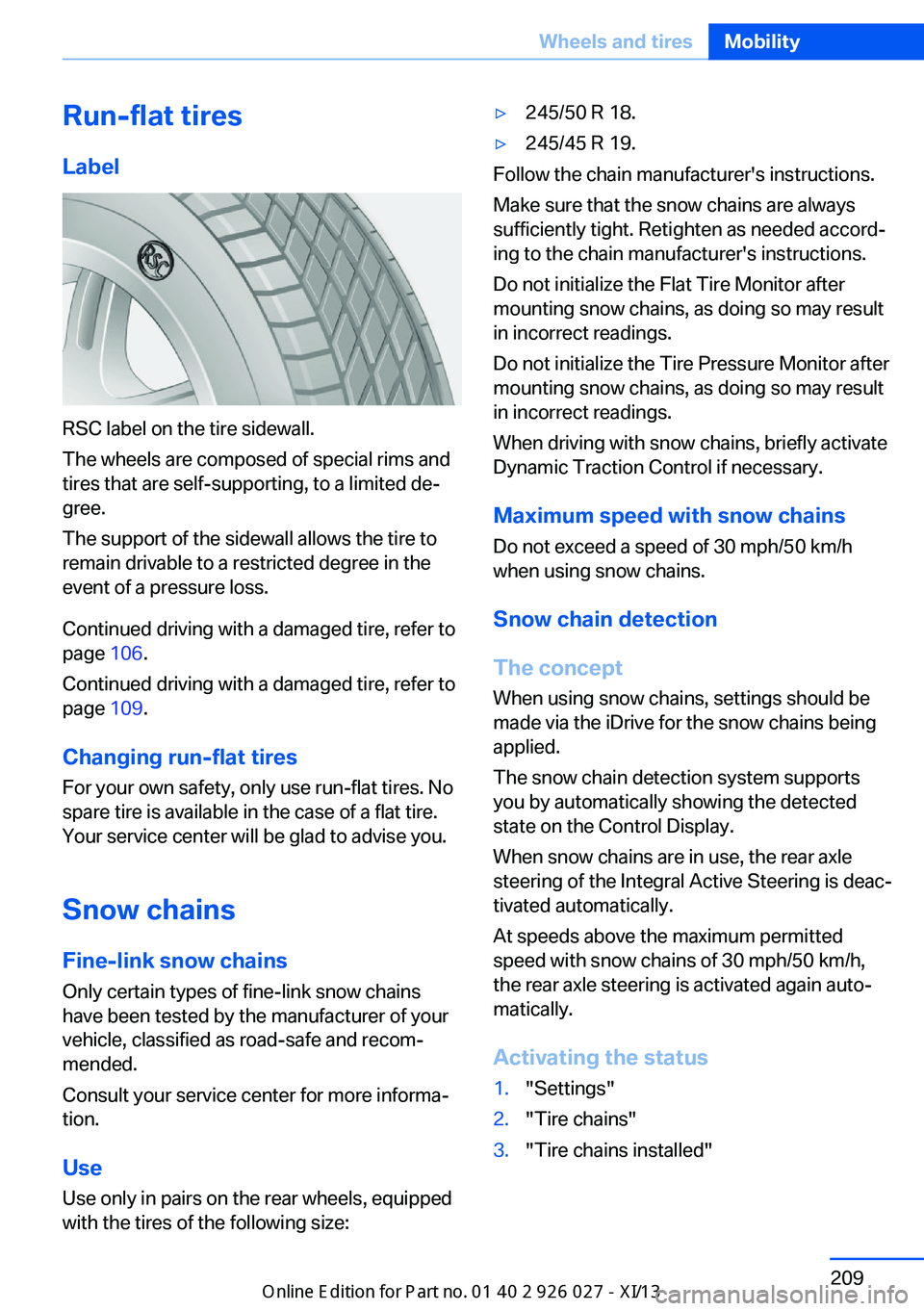2013 BMW 5 SERIES GRAN TURISMO spare tire
[x] Cancel search: spare tirePage 114 of 255

Control message is displayed. No flat tire or
loss of tire pressure can be detected.
Display in the following situations:▷A wheel without TPM electronics is fitted:
have the service center check it if neces‐
sary.▷Malfunction: have the system checked by
your service center.▷TPM was unable to complete the reset.
Reset the system again.▷Disturbance by systems or devices with
the same radio frequency: after leaving the
area of the disturbance, the system auto‐
matically becomes active again.
Declaration according to NHTSA/
FMVSS 138 Tire Pressure Monitoring
System
Each tire, including the spare (if provided)
should be checked monthly when cold and in‐
flated to the inflation pressure recommended
by the vehicle manufacturer on the vehicle
placard or tire inflation pressure label. (If your
vehicle has tires of a different size than the size
indicated on the vehicle placard or tire inflation
pressure label, you should determine the
proper tire inflation pressure for those tires.)
As an added safety feature, your vehicle has
been equipped with a tire pressure monitoring
system (TPMS) that illuminates a low tire pres‐
sure telltale when one or more of your tires is
significantly under-inflated. Accordingly, when
the low tire pressure telltale illuminates, you
should stop and check your tires as soon as
possible, and inflate them to the proper pres‐
sure. Driving on a significantly under-inflated
tire causes the tire to overheat and can lead to
tire failure. Under-inflation also reduces fuel ef‐
ficiency and tire tread life, and may affect the
vehicle's handling and stopping ability. Please
note that the TPMS is not a substitute for
proper tire maintenance, and it is the driver's
responsibility to maintain correct tire pressure,
even if under-inflation has not reached the
level to trigger illumination of the TPMS low
tire pressure telltale. Your vehicle has also
been equipped with a TPMS malfunction indi‐
cator to indicate when the system is not oper‐
ating properly. The TPMS malfunction indica‐
tor is combined with the low tire pressure
telltale. When the system detects a malfunc‐
tion, the telltale will flash for approximately one
minute and then remain continuously illumi‐
nated. This sequence will continue upon sub‐
sequent vehicle start-ups as long as the mal‐
function exists. When the malfunction indicator
is illuminated, the system may not be able to
detect or signal low tire pressure as intended.
TPMS malfunctions may occur for a variety of
reasons, including the installation of replace‐
ment or alternate tires or wheels on the vehicle
that prevent the TPMS from functioning prop‐
erly. Always check the TPMS malfunction tell‐
tale after replacing one or more tires or wheels
on your vehicle to ensure that the replacement
or alternate tires and wheels allow the TPMS
to continue to function properly.
Intelligent Safety
The concept Depending on how the vehicle is equipped, In‐
telligent Safety consists of one or more of the
following systems, which can help to avoid an
imminent collision. These systems are active
automatically every time the engine is started
using the Start/Stop button:▷Collision warning, refer to page 111.▷Pedestrian warning, refer to page 116.
Note
Personal responsibility
The system does not serve as a substi‐
tute for the driver's personal judgment of the
traffic situation.
Seite 110ControlsSafety110
Online Edition for Part no. 01 40 2 909 928 - VI/13
Page 212 of 255

Recommended tire brands
For each tire size, the manufacturer of your ve‐
hicle recommends certain tire brands. These
can be identified by a star on the tire sidewall.
With proper use, these tires meet the highest
standards for safety and handling.
New tires Due to technical factors associated with their
manufacture, tires do not achieve their full
traction potential until after an initial breaking-
in period.
Drive conservatively for the first
200 miles/300 km.
Retreaded tires
The manufacturer of your vehicle does not rec‐
ommend the use of retreaded tires.
Retreaded tires
Possibly substantial variations in the de‐
sign and age of the tire casing structures can
limit service life and have a negative impact on
road safety.◀
Winter tires
The manufacturer of your vehicle recommends
winter tires for winter roads or at temperatures
below +45 ℉/+7 ℃.
Although so-called all-season M+S tires do
provide better winter traction than summer
tires, they do not provide the same level of per‐
formance as winter tires.
Maximum speed of winter tires
If the maximum speed of the vehicle is higher
than the permissible speed for the winter tires,
then display a corresponding sign in the field
of vision. You can obtain this sign from the tire
specialist or from your service center.
Maximum speed for winter tires
Do not exceed the maximum speed for
the winter tires; otherwise, tire damage and ac‐
cidents can occur.◀
Run-flat tires If you are already using run-flat tires, for your
own safety you should replace them only with
the same kind. No spare tire is available in the
case of a flat tire. Your service center will be
glad to advise you.
Rotating wheels between axles The manufacturer of your vehicle advises
against switching wheels between the front
and rear axles.
This can impair the handling characteristics.
StorageStore wheels and tires in a cool, dry place with
as little exposure to light as possible.
Always protect tires against all contact with oil,
grease and fuels.
Do not exceed the maximum tire inflation pres‐
sure indicated on the side wall of the tire.Seite 208MobilityWheels and tires208
Online Edition for Part no. 01 40 2 909 928 - VI/13
Page 213 of 255

Run-flat tires
Label
RSC label on the tire sidewall.
The wheels are composed of special rims and
tires that are self-supporting, to a limited de‐
gree.
The support of the sidewall allows the tire to
remain drivable to a restricted degree in the
event of a pressure loss.
Continued driving with a damaged tire, refer to
page 106.
Continued driving with a damaged tire, refer to
page 109.
Changing run-flat tires
For your own safety, only use run-flat tires. No
spare tire is available in the case of a flat tire.
Your service center will be glad to advise you.
Snow chains
Fine-link snow chains
Only certain types of fine-link snow chains
have been tested by the manufacturer of your
vehicle, classified as road-safe and recom‐
mended.
Consult your service center for more informa‐
tion.
Use Use only in pairs on the rear wheels, equipped
with the tires of the following size:
▷245/50 R 18.▷245/45 R 19.
Follow the chain manufacturer's instructions.
Make sure that the snow chains are always
sufficiently tight. Retighten as needed accord‐
ing to the chain manufacturer's instructions.
Do not initialize the Flat Tire Monitor after
mounting snow chains, as doing so may result
in incorrect readings.
Do not initialize the Tire Pressure Monitor after
mounting snow chains, as doing so may result
in incorrect readings.
When driving with snow chains, briefly activate
Dynamic Traction Control if necessary.
Maximum speed with snow chains Do not exceed a speed of 30 mph/50 km/h
when using snow chains.
Snow chain detection
The concept When using snow chains, settings should be
made via the iDrive for the snow chains being
applied.
The snow chain detection system supports
you by automatically showing the detected
state on the Control Display.
When snow chains are in use, the rear axle
steering of the Integral Active Steering is deac‐
tivated automatically.
At speeds above the maximum permitted
speed with snow chains of 30 mph/50 km/h,
the rear axle steering is activated again auto‐
matically.
Activating the status
1."Settings"2."Tire chains"3."Tire chains installed"Seite 209Wheels and tiresMobility209
Online Edition for Part no. 01 40 2 909 928 - VI/13
Page 226 of 255

2.Pull down the cover with a firm tug.3.Pull off the connector toward the left.4.Replace the bulb.
Inside brake lamp
To change the brake lamp, contact your serv‐
ice center.
Reversing lamp
16-watt bulb, W16W.
Turn the bulb, pull it out, and replace it.
Changing wheels
Hints
The vehicle equipment does not include a
spare tire.
When using run-flat tires or tire sealants, a tire
does not need to be changed immediately in
the event of pressure loss due to a flat tire.
The tools for changing wheels are available as
accessories from your service center.
Jacking points for the vehicle jack
The jacking points for the vehicle jack are lo‐
cated at the positions shown.
Vehicle battery Maintenance
The battery is maintenance-free, i.e., the elec‐
trolyte will last for the life of the battery.
Seite 222MobilityReplacing components222
Online Edition for Part no. 01 40 2 909 928 - VI/13
Page 251 of 255

Roll stabilization, see Dy‐namic Drive 130
RON gasoline quality 200
Roof load capacity 237
Roof-mounted luggage rack 188
Rope for tow-starting/ towing 229
RSC Run Flat System Com‐ ponent, refer to Run-flat
tires 209
Rubber components, care 232
Run-flat tires 209
S Safe braking 185
Safety 7
Safety belt reminder for driv‐ er's seat and front passen‐
ger seat 54
Safety belts 54
Safety belts, care 232
Safety Package, refer to Ac‐ tive Protection 124
Safety switch, windows 46
Safety systems, airbags 102
Saving fuel 190
Screen, refer to Control Dis‐ play 16
Screwdriver 218
Screw thread for tow fit‐ ting 229
Seat belts, refer to Safety belts 54
Seat heating, front 52
Seat heating, rear 53
Seating position for chil‐ dren 61
Seat, mirror, and steering wheel memory 57
Seats 49
Seats, rear, adjusting 53
Seat ventilation, front 52 See lamp and bulb replace‐
ment 218
Selection list in instrument cluster 92
Selector lever, automatic transmission 78
Self-leveling suspension, air suspension 131
Self-leveling suspension, malfunction 132
Sensors, care 233
Service and warranty 7
Service history 90
Service requirements, Condi‐ tion Based Service
CBS 216
Service requirements, dis‐ play 89
Service, Roadside Assis‐ tance 226
Services, ConnectedDrive
Settings, locking/unlock‐ ing 42
Settings on Control Dis‐ play 95
Settings, storing for seat, mir‐ rors, steering wheel 57
Shifting, automatic transmis‐ sion 78
Shift paddles on steering wheel 79
Shoulder support 52
Side airbags 102
Side View 151
Signaling, horn 12
Signals when unlocking 42
Sitting safely 49
Size 236
Ski and snowboard bag 175
Slide/tilt glass roof 47
Smallest turning circle 237
Smoker's package 171
Snow chains 209
Socket 172
Socket, OBD Onboard Diag‐ nostics 217 SOS button 225
Spare fuse 223
Speaker lighting 101
Specified engine oil types 214
Speed, average 93
Speed limit detection, on‐ board computer 94
Speed limiter, display 91
Speed Limit Information 91
Speed limit in the com‐ puter 94
Split screen 20
SPORT+ - program, Dynamic Driving Control 133
Sport automatic transmis‐ sion 79
SPORT program, driving dy‐ namics 133
Sport program, transmis‐ sion 79
Stability control systems 127
Start/stop, automatic func‐ tion 69
Start/Stop button 67
Start function during malfunc‐ tion 31
Starting the engine 68
Status display, tires 107
Status information, iDrive 20
Status of Owner's Manual 6
Steering, Integral Active Steering 131
Steering wheel, adjusting 59
Steering wheel heating 60
Steering wheel memory 57
Steptronic, automatic trans‐ mission 78
Stopping the engine 68
Storage compartment in the center console 179
Storage compartments 177
Storage compartments, loca‐ tions 177
Storage, tires 208
Storing the vehicle 233 Seite 247Everything from A to ZReference247
Online Edition for Part no. 01 40 2 909 928 - VI/13